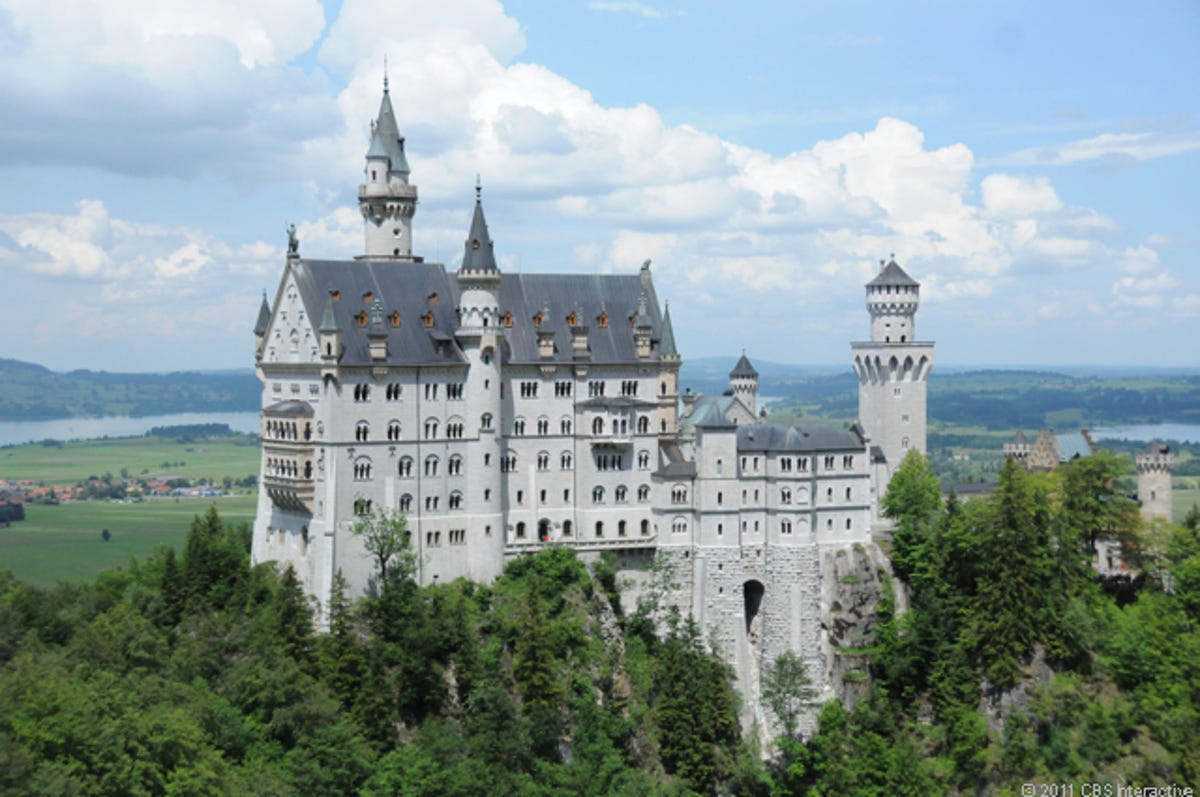'Mad' King Ludwig's fairytale castle (photos)
Road Trip 2011: More than 1.3 million people visit Neuschwanstein Castle every year for its beauty and its incredible Alpine setting. CNET takes you, too, on this photo tour.

Classic shot
SCHWANGAU, Germany--This is the world famous Neuschwanstein Castle, the onetime home of "Mad" King Ludwig II. Ludwig, who was King of Bavaria from 1864 to 1886, wanted a home near the castle he grew up in--known as Hohenschwangau--that he could retreat to and get away from the sycophants who plagued him, as well as the public. Work began in 1869 and ended in 1886.
But Ludwig nearly bankrupted the monarchy making the castle, and in order to remove him from the throne, he was declared insane. Arrested in his bedroom in the castle--which was still not finished--he was taken to another palace in Munich. There, the next day, he went for a walk with his psychiatrist, and later that evening, the two were found dead. The cause of their deaths was never determined to anyone's satisfaction.
These days, Neuschwanstein is one of the most visited attractions in Europe, with more than 1.3 million annually, despite its inconvenient location in southern Bavaria, just across the Austrian border. Here, we see a classic view of the castle from the famous Marianbrucke bridge.
CNET reporter Daniel Terdiman visited Neuschwanstein as part of Road Trip 2011.
View with mountains
This is an iconic view of Neuschwanstein with the Alps behind it, taken on a fall day. The castle was never finished and to this day, its entire second floor remains incomplete.
Ideal design
Ludwig had a penchant for all things German medieval, as well as noble. His ideal design for his new castle was a combination of the medieval and the romantic, as seen here in this design drawing from 1869.
After his death
This photograph of Neuschwanstein was taken shortly after King Ludwig's death and shows the scaffolding that conveys that the castle was never finished--even when the king was living there, as he did for about six months before his arrest and untimely death at the age of 41.
From below and the side
This is a view of the castle from below and to the side. The castle sits high above the small village of Schwangau in Bavaria.
Gate house
This is a view of the Neuschwanstein gate house, the main entryway into the castle.
The throne room
This is a photograph of the Throne Room in Neuschwanstein. A glorious room, it is missing one important element, the throne. It was not finished prior to Ludwig's death and upon his demise, the decision was made to stop working on it.
Singer's Hall
This is the Singer's Hall in Neuschwanstein Castle.
Cave
A lover of opera, Ludwig dedicated Neuschwanstein to the operatic works of Richard Wagner. As well, he had this grotto constructed as a small token "scene" he could wander through whenever he needed a taste of opera.
Below front
Here we see a view of Neuschwanstein from below.
Far below
Here we see another view of Neuschwanstein, this time from below and far away.
Main gate interior
This is a view of the interior of the Neuschwanstein gate house and the courtyard inside.
Courtyard
Here we see a view of the courtyard inside the gate house of Neuschwanstein Castle.
Hohenschwangau from Neuschwanstein
In this picture, we can see the Austrian Tyrolean Alps, the Alpsee Lake, and on the right side, Hohenschwangau Castle, where King Ludwig II grew up. This castle was constructed by his father, King Maximilian, to replace the original castle on the site, known as Schwanstein. This photo was taken from Neuschwanstein, which means New Schwanstein Castle.
From the rear and below
This is a view of Neuschwanstein Castle from below and to the rear.
Lego Neuschwanstein
This is a photograph of a model of Neuschwanstein made entirely of Lego bricks. The model is located at Legoland in Billund, Denmark.
Bedroom
This is King Ludwig's bedroom in Neuschwanstein Castle.
The towers of Neuschwanstein
These are the towers above the roof of Neuschwanstein.
Hohenschwangau from below
This is Hohenschwangau Castle, as seen from below, in the village of Schwangau, Germany.
Hohenschwangau from Neuschwanstein
This is Hohenschwangau Castle, as seen from Neuschwanstein.
Hohenschwangau from just below
Here we see Hohenschwangau from the path that leads up to the castle.
Neuschwanstein from Hohenschwangau
Here we see Neuschwanstein Castle through the tower of Hohenschwangau.
The kitchen
This is a look at the kitchen in Neuschwanstein Castle, which was one of the most advanced of its day.
St. George and the Dragon
This is a painting of St. George and the Dragon, located inside Neuschwanstein Castle. Most of the artworks inside the castle were based on the themes explored in the operas of Richard Wagner. King Ludwig dedicated the castle to Wagner's operas.

